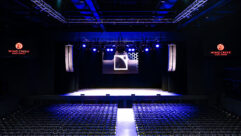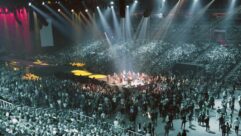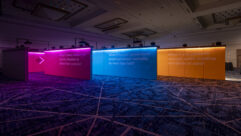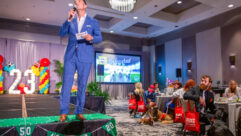THE MAIN EVENT
Apr 1, 2002 12:00 PM,
By Keith Clark
It’s called “the world’s most famous arena” because,quite simply, it is. For more than 100 years, Madison Square Garden hasbeen center stage for many of the most memorable sporting andentertainment performances witnessed by several generations. Aprocession of four facilities have been erected at the same spot inManhattan over the span of a century, all carrying the Madison SquareGarden moniker, with the latest incarnation opening in 1968. Inaddition to serving as the home of the New York Knicks and New YorkRangers, the circular, 20,000-seat arena hosts a steady procession ofevents including circuses, prize fights, concerts, rodeos and even theNew York City Police Department Academy graduation and the venerableWestminster Kennel Dog Show.
About two years ago, Felix Robinson, audio supervisor for theGarden, recommended a new system to replace the one that had servedadmirably for more than a decade. Garden management concurred,procuring the budget for a project slated for completion in September2001, just in time for the first face-off of the hockey season.
The previous system had been designed and installed by CliffHenricksen, who also served as audio supervisor at the Garden beforedeparting to provide product design for two leading manufacturers.Robinson had assisted Henricksen and learned a great deal both aboutthe system and audio principles prior to the handoff. The old systemoffered three-way loudspeaker clusters divided among four primarypositions at ceiling level, each handling roughly a quarter of thecoverage area. As in the recent project, the clusters were subject tosevere aesthetic restrictions in deference to the Garden’s distinctiveceiling. The subsequent addition of numerous advertising signs in thearena created several shadowed seating regions, necessitating theaddition of distributed loudspeakers.
“The prior system was well designed for its time, and withsome extra care from Cliff (and me, later on) it had what can beconsidered an extended life span,” Robinson said. “Finally,it became apparent that an upgrade was in order, to take advantage ofmany technological advancements that would result in more flexibility,easier use and better overall sound quality and coverage.”
Garden management designated Wrightson, Johnson, Haddon andWilliams of Dallas as the system design consulting firm on the project,with Jack Wrightson and senior designer Ron Baker heading the process.Signal Perfection Ltd., based in Columbia, Maryland, emergedfrom the bidding process as the contractor. SPL’s Larry Politi put inseven-day weeks as project manager over the course of the installation,and SPL project engineer Ed Sullivan matched that commitment insupplying the lion’s share of custom digital signal processingprogramming. They worked closely with Robinson, who also serves asSPL’s operations manager for the Northeastern United States.
COMPLICATING FACTORS
A tight time frame proved the biggest non-audio factor influencingthe project. It was a situation complicated by two vastly differentissues. First, the preliminary design was not fully approved untilJune. Final working drawings, the bidding process and installation wereyet to be done as a late September deadline loomed. Then, on September11, as SPL shepherded the diverse crew through installation of newelectrical service, cabling, racks, electronics, loudspeakers and theircustom steel support structures, work came to a jarring halt. Uponhearing word of the attack, workers immediately left the project siteto offer their help and support at ground zero. The tight deadline wasput on hold for a more important priority.
“The events of September 11 created a shift in that the arenawouldn’t be doing business for several days, but at some point there’sthe reality that the show must go on; therefore, the system had to befinished as expediently as possible,” Robinson said. “Ourexperience with arena projects over the years was a real benefit. Weconvened an emergency meeting a few days later to figure out how toaccelerate the schedule to make the deadline — really, to upholdour commitment to the client despite the uncertainty. We coordinat[ed]manpower and came up with a schedule that actually allowed us to leapahead.
“Just getting people in and out of the city was an incrediblechallenge,” he said. “There were bomb threats all over thecity, several of them at Penn Station, which sits directly under theGarden. All deliveries were subject to exhaustive inspections.Regardless, work resumed, because every individual pushed even hardertoward honoring the commitment. The result was the first official useof the new system for a championship boxing match on September22.”
A major contributor in making this deadline, despite theconsiderable difficulties, was Politi’s organized and accurate projectreporting. Distributed to all of the trades on the project, thesereports provided a valuable resource for keeping work flowing smoothly,on track and with high quality, even in light of the disaster/recoverydelay period.
Early in the planning phase, the sound team had settled on athree-part replacement process to smooth the transition from old tonew. A temporary system, made up of EAW KF860 line-array modulesand KF853 “high Q” loudspeakers, was distributed centrallyand provided quality audio over the period when the old system wasdecommissioned and the new one was not quite ready.
“There was a three-day window in which the three loudspeakersystems were all in place at the ceiling,” Robinson said.“It was pretty cluttered, but at the same time, the ceilinglooked kind of like a loudspeaker museum, which was neat.”
VISUAL DISTINCTION
The arena’s one-of-a-kind ceiling is its defining visual signature,and management is justifiably concerned with anything that might be adetraction — improved sound system included. Bronze-tinted metalpanels, best described as steel flutes, are suspended to form twoprimary concentric rings. The perforated panels are backed byfiberglass-based absorptive material that enhances the acousticalsignature of the room.
“It’s rare for any modern arena to even have a ceiling. Mostoffer large, open expanses with exposed structure,” Baker said.“Acoustically, this keeps the internal volume of the room down,so it is more intimate in comparison to typical spaces of this type.Official measurements of noise and reflection were deemed unnecessary,but there’s no doubt the ceiling helps tame acoustical energy withinthe space.”
Maximum floor-to-ceiling height of approximately 80 feet (as opposedto the usual 120-130 feet) occurs at the very center of the arena, withheight diminishing from there as seating tiers rise consistently towardthe outer edge of the circular room. The numerous seating levels stayconsistent all the way around, topped by single row of luxury suites.What’s gained acoustically by this arrangement creates a rigidaesthetic requirement in that loudspeaker clusters must not detractfrom the ceiling. Conventional clusters were not an acceptablesolution.
“Our first pass at the design used flattened clusters, whichwouldn’t extend down in length below ceiling level much more than oneloudspeaker cabinet,” Baker said. “The object was to stackthem, one behind the other, in order to attain necessarycoverage.”
After receiving the initial main cluster design — composed ofa series of three cabinets arrayed vertically — managementactually built full-size cardboard mockups of the clusters and put theminto position to evaluate how they would look. The mockups were evenpainted to look like loudspeakers. Management wanted some adjustments,and ultimately WJHW revised its design, further minimizing the heightof the clusters while still attaining the required sonicperformance.
EASE modeling played an even bigger role than usual in thesecond pass, helping to speed the process of precise ly arrangingloudspeakers in position and flying angle while also determining theimpact of those factors on coverage. In addition, it assisted indefining the impact of shadowing by signage and other structuralelements.
FILLING THE GAPS
each application of the system is a bit unique, but the overall goalwas complete, even coverage of every seat, assured by the use ofappropriate loudspeakers and optimized placement. Additional tailoringto meet the needs of a given application could be attained withconfigurable digital signal processing and matrixing on the system’sfront end.
The circular nature of the room served as the basis of theloudspeaker layout. Whereas the previous system had been based on fourcluster locations, the new system would have eight, achieving both theaesthetic and audio goals. Delayed distributed loudspeakers were deemednecessary as well. “It’s quite challenging to fill seams and gapsif your loudspeakers are 90 degrees apart, so by grouping clustersevery 45 degrees, there’s much better chance of attaining the desiredblanket of coverage,” Baker said. “This is alsoadvantageous when you’re limited in structure options, and thealternative is more loudspeaker locations and moredistribution.”
The eight primary clusters are arranged in an evenly spaced circle.Each cluster, comprised of only two vertically arrayed loudspeakers, isattached to custom steel flying structures about 50 feet from theroom’s center point, anchored by a large scoreboard. The clustersconsist of EAW MQV Series loudspeakers, designed expressly for fixedinstallation applications requiring high output with tight patterncontrol. WJHW has successfully used EAW for past stadium and arenaprojects, which was a factor in the company’s loudspeakerselection.
The first loudspeakers in each pair are MQV1366 full-range,three-way loudspeakers, firing almost straight down. Their 60-degreevertical coverage pattern, with their downward aim and proximity tomany of the seats, adequately spreads coverage. Each of theseloudspeakers includes a 15-inch low-frequency woofer (in a ventedsubenclosure), a 10-inch horn-loaded midrange and a 2-inch exitcompression driver on a 60-by-60-degree constant-directivity horn.Added attention is given to the midrange section of the MQVloudspeakers, with the 10-inch cone outfitted with a modified geometrythat enhances a time-coherent wavefront through the upper portion ofthe midrange, which is critical to vocal articulation. In addition, aphase plug with radial slots reduces mechanical resistance between thedriver and horn.
Directly behind these loudspeakers, single MQV2364 loudspeakersextend coverage to the mid-seating levels, with maximum throw distancesof about 90 feet. The increased throw requirement is aided in part bythis loudspeaker’s dual 15-inch low-frequency section and dual 10-inchmidrange. The geometry of their location relative to the coverage areadictated a 60-by-40-degree pattern, with any transitions betweenloudspeakers confined to aisles.
Increased system dynamics, to match modern production expectations,resulted in the inclusion of 16 Bag End Quartz subwoofers, eachincorporating four 18-inch drivers (for a total of 64). Divided intotightly packed pairs and also firing almost straight down, thesesubwoofers reside directly behind the main clusters, with theircompanion ELF processors mounted in the equipment racks above theceiling. Capable of extended low frequencies down to 28-30 Hz, theirexact cutoff point is still being refined.
SHADOWED REGIONS
The distributed delay ring of loudspeakers also forms a circle andresides about 80 feet into the house. Also comprised of single MQV1366full-range units, they extend coverage to the upper-most levels ofseating as well as to the exterior seats of each luxury suite. Atselect locations, they are joined by single sidecar loudspeakers— Renkus-Heinz TRAP40MH/6s — that fire backward toreach seats shadowed when the dasher board/plexiglass panels for hockeygames are in place.
Even with the delay ring, the uppermost rows of the upper level arestill shadowed by the luxury suites. A two-part process solves theproblem. Renkus-Heinz TRC82/12 compact loudspeakers, mountedhorizontally to remain low-profile, handle most of this coverage. Theyare mounted to the underside of the suites and fire back. The last tworows in these regions remain shadowed, so OWI compact two-wayloudspeakers, similarly mounted, add mid-high energy. More TRC82/12s dothe same for a region at mid-level shadowed by another scoreboard withsignage, and all of these loudspeakers are run with 70V lines.
The underside of the main scoreboard hosts eight additionalloudspeakers used primarily for courtside seats in basketballconfiguration. These EAW AOS130 loudspeakers (four per side) arevirtually invisible given their low profile. These 15-inch LF,60-by-40-degree speakers were first developed as a joint effort betweenWJHW and EAW for the system at Atlanta’s Olympic Stadium, now TurnerField. WJHW continues to use them for unique situations at stadiums andarenas.
“Coverage throughout the arena, regardless of theconfiguration or event, is solidly attained with this loudspeakersset,” Baker said. “It was certainly a unique challengewithin the footprint. The maximum depth of any cluster is just fourfeet, so the desired impact of the ceiling is maintained. The output ofthe devices and their inherent pattern control contributed to makingthis work, and the subs add a nice touch of impact. Overall, both sonicand aesthetic objectives were met.”
Garden management brought in some of the facility’s originalstructural engineers to advise on the location and securing of the newclusters. They worked with SPL and Mountain Productions‘ JimEvans, providing information leading to the prudent addition ofsecondary steel to support the new cabinets, as well as the system’samplifier and processing racks also flown centrally above ceilinglevel.
“Mountain Productions was superior in their role as riggingsupervisor,” Robinson said. “They also helped us solve sometough problems at several positions where we had to span over andaround duct work with custom steel rigging to insure clusters were inthe optimum positions to deliver coverage.”
RACKS ABOVE
The racks of gear providing power from their lofty perch aboveceiling level (also the location of the previous system racks) includeQSC PL Series (LF and MF) and CX Series (HF) power amplifiers,with a QSControl package allowing them to be controlled and monitoredthrough a laptop PC at the house mix position. Originally, the existingracks were going to be used, but it became more practical to replacethem with newer models.
To accommodate the substantial increased power requirements of thenewer, more dynamic system, electrical service to the rack region wasincreased five fold. About 700 amps of single phase AC were put intoplace ahead of time, and then simply routed to the racks after theywere installed. All power is regulated with a LynTec motorizedbreaker system.
The racks also house networked BSS Soundweb 9088ii digitalsignal processor and matrixing units. All are networked with a masterSoundweb 9000ii hub, and the laptop PC at the mix position, again,provides convenient control. Sullivan programmed a host of systempresets for the various required configurations, and all are passwordprotected to prevent unauthorized access.
System operators have a dramatically simplified method for selectingthe desired system configuration through a series of switches at themix position. Any further tailoring is done with the newSoundcraft K2 console. Operators are not highly trained audioprofessionals, but members of International Brotherhood of ElectricalWorkers Local 3 are on staff at the Garden.
“One of the challenges of my role as audio supervisor iskeeping the system at peak performance even though it’s operated by adiverse group of individuals, some with an interest and talent forsound and some without,” Robinson said. “It’s a position ofdiplomacy, of listening and interpretation, as well as one ofeducation. It dictates that we supply a simplified interface toguarantee quality that can be attained without a huge amount oftraining.”
The mix position is actually located in the house and is carved outof section of mid-level seating. It’s advantageous for providing aclear picture of what the system is doing during a performance. Inaddition, WJHW included a redundant system for routing audio from thisposition; one feed goes over the Soundweb digital bus, and the backupuses an eight-channel QSC RAVE D/A and A/D system. Should both of thesefail, there’s a good, old-fashioned copper wire link to the racks.“It’s a fairly fail-safe way of being sure we always have signalgoing to the racks,” Baker said.
The previous system’s Soundcraft K1 console serves as a backup,which is located in a nearby electrical room. In case of failure atmain position, just a single multipin cable needs to be repatched torun the entire system from this alternate location.
CONTINUING TWEAKS
The open space between the ceiling and the roof lessened thechallenge of installing infrastructure throughout the existingbuilding. A lot of cabling has built up over time; some was removed andsome was left in place. Optimization of the preset systemconfigurations continues, along with the addition of new processor setswhen necessary. Operation staff has undergone fairly extensivetraining, mainly provided by Politi. To this point, the system, interms of both performance and functionality, has met expectations.
Jack Wrightson performed final tuning and analysis, and prior to hiswork, Sam Berkow, founder of SIA Software company, worked with Sullivanon refining the processing within the basic Soundweb sets (see “ASubtle Magic” on page 70).
All parties concur that sonic performance goals have been met, evenwhile further tweaking continues. “Our first real test with afull house was when Michael Jordan and his Washington Wizards visitedfor a game with the Knicks. [The system] proved satisfactory,”Robinson said. “Everyone on the system team agreed that what wehave now sounds much better than we even expected. Coverage was fulland even, and there’s plenty of headroom in terms of both volume anddynamics.”
Keith Clark is an independent writer for the professional soundindustry and has authored hundreds of system application articles.
For More Information
Bag End
bagend.com
Circle 235 on Reader Service Card
BSS Audio
bss.co.uk
Circle 236 on Reader Service Card
EAW
eaw.com
Circle 237 on Reader Service Card
LynTec
lyntec.com
Circle 238 on Reader Service Card
Mountain Productions
mountainproductions.com
OWI
owi-inc.com
Circle 239 on Reader Service Card
QSC
qscaudio.com
Circle 240 on Reader Service Card
Renkus-Heinz
renkus-heinz.com
Circle 241 on Reader Service Card
Signal Perfection Ltd.
splis.com
Circle 242 on Reader Service Card
Soundcraft
soundcraft.com
Circle 243 on Reader Service Card
Wrightson, Johnson, Haddon & Williams
wjhw.com










